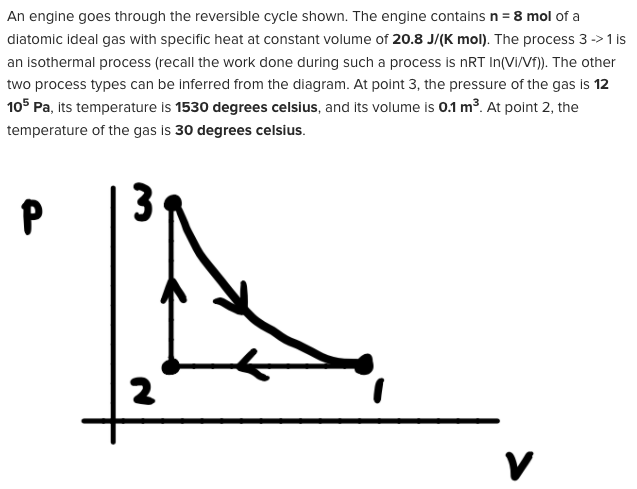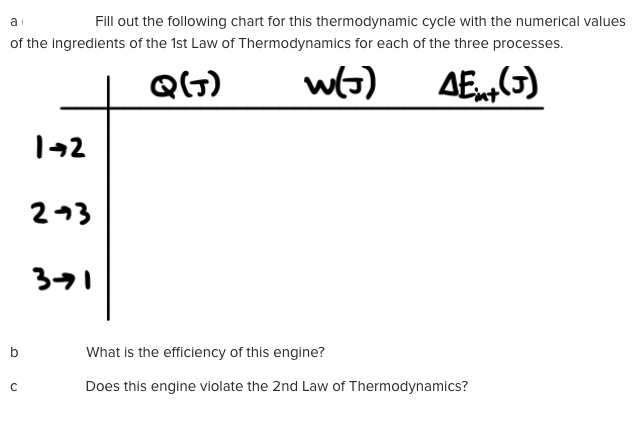An engine goes through the reversible cycle shown. The engine contains n= 8 mol of a diatomic ideal gas with specific heat at constant volume of 20.8 J/(K mol). The process 3 ->1 is an isothermal process (recall the work done during such a process is nRT In(VIVF). The other two process types can be inferred from the diagram. At point 3, the pressure of the gas is 12 105 Pa, its temperature is 1530 degrees celsius, and its volume is 0.1 m3. At point 2, the temperature of the gas is 30 degrees celsius. Fill out the following chart for this thermodynamic cycle with the numerical values of the ingredients of the 1st Law of Thermodynamics for each of the three processes. QG) wl3) AE(3) 142 243 371 What is the efficiency of this engine? Does this engine violate the 2nd Law of Thermodynamics?
An engine goes through the reversible cycle shown. The engine contains n= 8 mol of a diatomic ideal gas with specific heat at constant volume of 20.8 J/(K mol). The process 3 ->1 is an isothermal process (recall the work done during such a process is nRT In(VIVF). The other two process types can be inferred from the diagram. At point 3, the pressure of the gas is 12 105 Pa, its temperature is 1530 degrees celsius, and its volume is 0.1 m3. At point 2, the temperature of the gas is 30 degrees celsius. Fill out the following chart for this thermodynamic cycle with the numerical values of the ingredients of the 1st Law of Thermodynamics for each of the three processes. QG) wl3) AE(3) 142 243 371 What is the efficiency of this engine? Does this engine violate the 2nd Law of Thermodynamics?
Principles of Physics: A Calculus-Based Text
5th Edition
ISBN:9781133104261
Author:Raymond A. Serway, John W. Jewett
Publisher:Raymond A. Serway, John W. Jewett
Chapter18: Heat Engines, Entropy, And The Second Law Of Thermodynamics
Section: Chapter Questions
Problem 61P
Related questions
Question
An engine goes through the reversible cycle shown. The engine contains n = 8 mol of a diatomic ideal gas with specific heat at constant volume of 20.8 J/(K mol). The process 3 -> 1 is an isothermal process (recall the work done during such a process is nRT ln(Vi/Vf)). The other two process types can be inferred from the diagram. At point 3, the pressure of the gas is 12 105 Pa, its temperature is 1530 degrees celsius, and its volume is 0.1 m3. At point 2, the temperature of the gas is 30 degrees celsius.
See image for following questions and keep answers for 3 significant figures.

Transcribed Image Text:An engine goes through the reversible cycle shown. The engine contains n= 8 mol of a
diatomic ideal gas with specific heat at constant volume of 20.8 J/(K mol). The process 3 ->1 is
an isothermal process (recall the work done during such a process is nRT In(VIVF). The other
two process types can be inferred from the diagram. At point 3, the pressure of the gas is 12
105 Pa, its temperature is 1530 degrees celsius, and its volume is 0.1 m3. At point 2, the
temperature of the gas is 30 degrees celsius.

Transcribed Image Text:Fill out the following chart for this thermodynamic cycle with the numerical values
of the ingredients of the 1st Law of Thermodynamics for each of the three processes.
QG)
wl3)
AE(3)
142
243
371
What is the efficiency of this engine?
Does this engine violate the 2nd Law of Thermodynamics?
Expert Solution
This question has been solved!
Explore an expertly crafted, step-by-step solution for a thorough understanding of key concepts.
This is a popular solution!
Trending now
This is a popular solution!
Step by step
Solved in 7 steps with 13 images

Knowledge Booster
Learn more about
Need a deep-dive on the concept behind this application? Look no further. Learn more about this topic, physics and related others by exploring similar questions and additional content below.Recommended textbooks for you

Principles of Physics: A Calculus-Based Text
Physics
ISBN:
9781133104261
Author:
Raymond A. Serway, John W. Jewett
Publisher:
Cengage Learning


Physics for Scientists and Engineers: Foundations…
Physics
ISBN:
9781133939146
Author:
Katz, Debora M.
Publisher:
Cengage Learning

Principles of Physics: A Calculus-Based Text
Physics
ISBN:
9781133104261
Author:
Raymond A. Serway, John W. Jewett
Publisher:
Cengage Learning


Physics for Scientists and Engineers: Foundations…
Physics
ISBN:
9781133939146
Author:
Katz, Debora M.
Publisher:
Cengage Learning